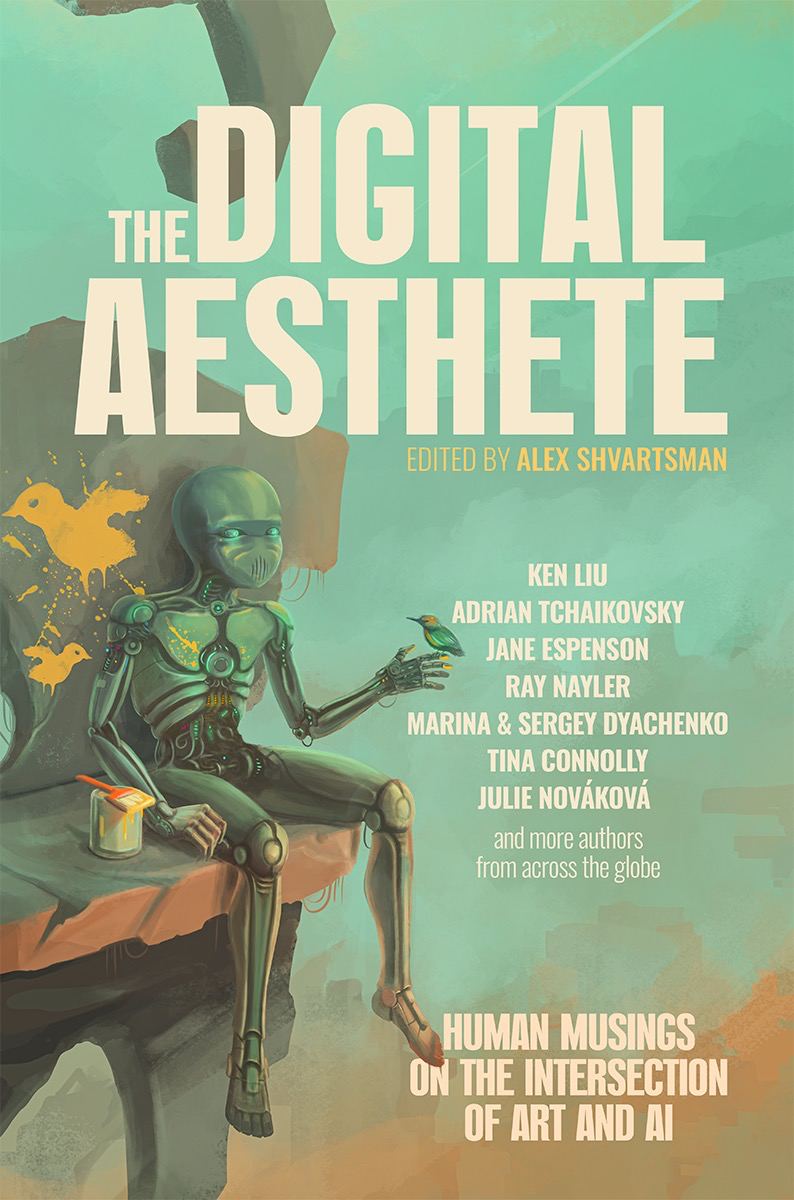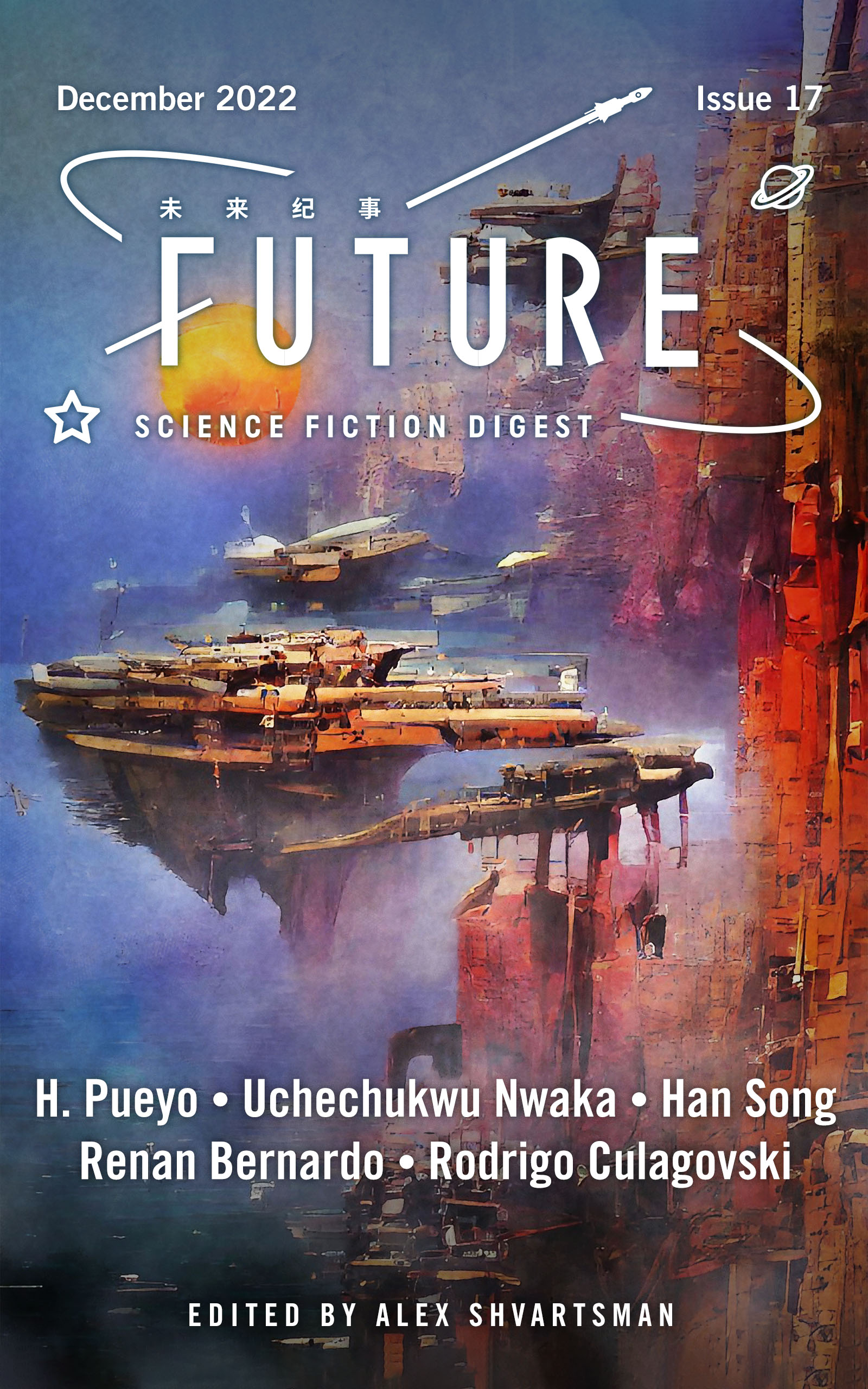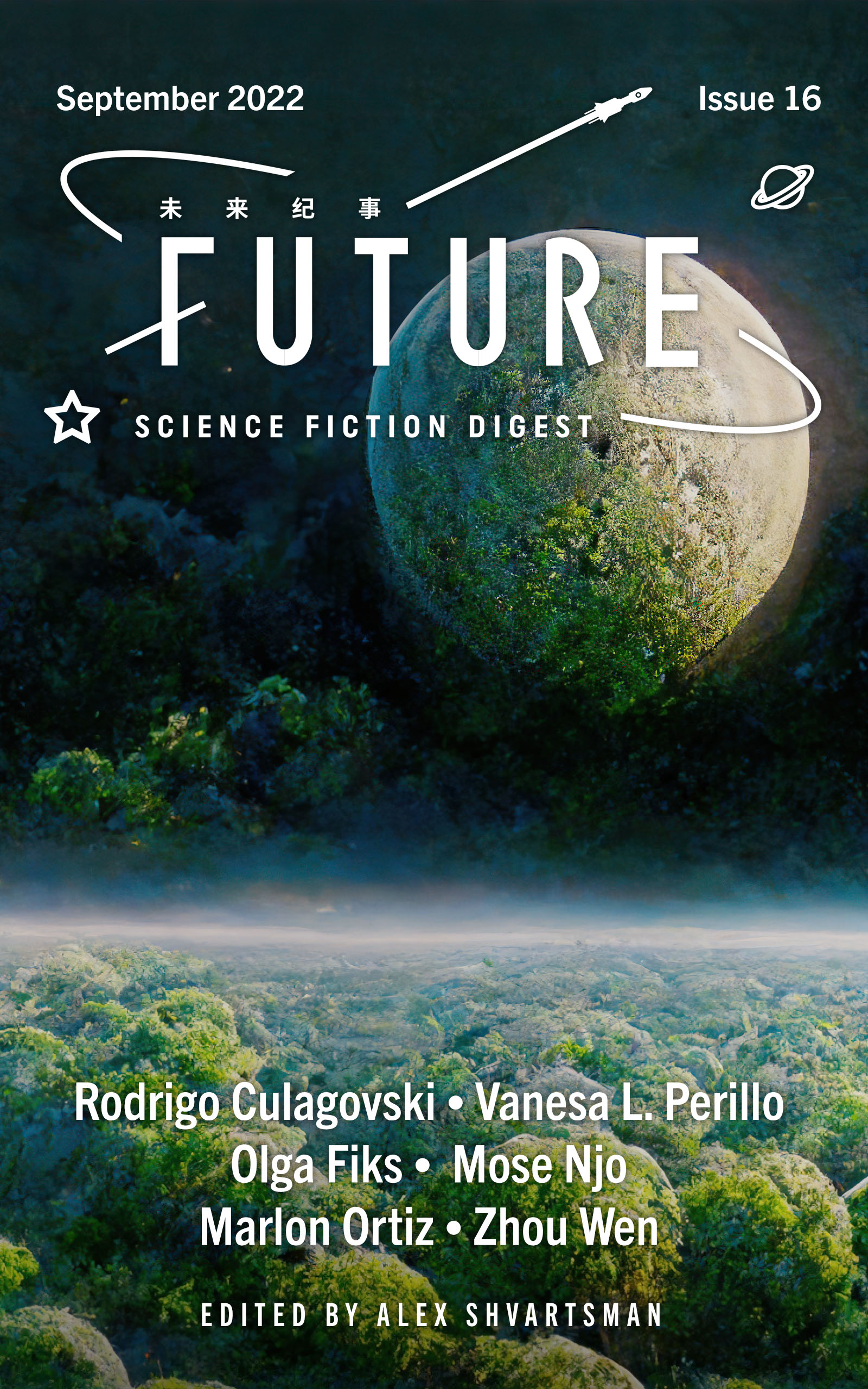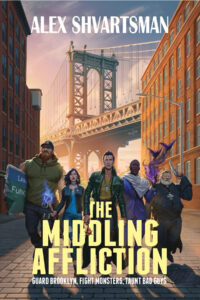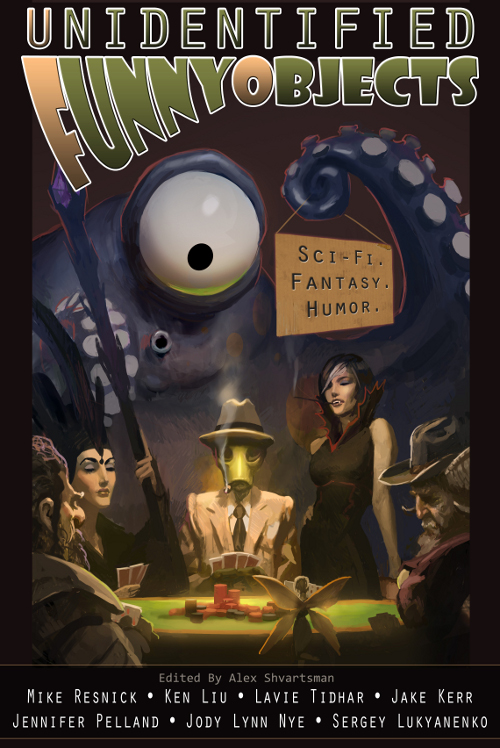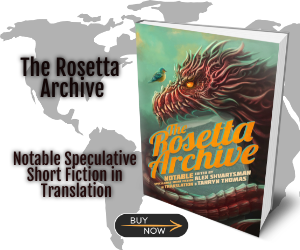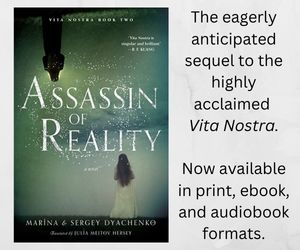When Bob looked out the window, he felt like he had seen the woman passing by somewhere before.
The abundant hair falling over her shoulders was going gray. She must have been in her fifties or so? Definitely older than Bob. She wore a hip wrap over running tights with a black hoodie. This was a style you saw often in Portland. Bob imagined her taking a nice run before heading to a coworking space to do her desk job and then, at lunchtime, walking down to Park Avenue where all the food trucks lined up.
She said hi to the guy running the kebab truck as she cut across the street and floated up the stoop of the building on the other side: the science fiction bookstore, Rose SF Wagon. From the ease of her movement and the tote bag bulge that could only be paper books, it was clear that she worked in an industry adjacent to Bob’s.
Where have I met her? he wondered. He’d been publishing the science fiction magazine Twisted World for twelve years now, so he interacted with many people whose names and faces he hadn’t connected. Whenever he went to a convention, there were fans who came to tell him their impressions, young writers who wanted him to read their work, editors and illustrators looking for a job. Bob made a point of going around to meet people too.
But when her face reflected in a glass window as she entered the shop, the mystery was solved.
“Oh, the Reader Alice glasses.”
The angular, red, plastic-framed glasses she was wearing looked a lot like the ones from a service for editors he used called Reader Alice. Even from across the road, he could tell that her face, with the kind of smile that makes everyone else happy too, wasn’t one he knew. It had to be the glasses. He must have mistaken the woman for someone he knew because those glasses were the same as the ones in the icon of the service he used every day.
Satisfied with that explanation, Bob sighed and glanced across the windows floating above his desk.
It had been a productive morning.
He’d been the first to arrive at the coworking space at eight-thirty and had worked straight through till now. When he bent the fingers of his right hand back with his left and took the whole arm in a twist, his stiff shoulder blade audibly popped. Savoring the pleasurable pain, he reviewed each window one by one.
In the upper-righthand corner of a word processor window displaying a short story called “Like Roaming Sea Dragons” was an icon with the glasses the woman had been wearing. Reader Alice. The sleepy-looking eyes inside the frames looked at Bob every now and then, indicating that she was waiting for instructions. Next to the manuscript was a window with NASA’s website open to a page with information about the exoplanet the story was set on. There was a Reader Alice icon there too.
On the other side of the website floated a notepad where Bob had been writing things down; red threads connected his notes to markers in the manuscript. The notepad also had a Reader Alice icon.
On the left side of his desk, the three-window stack that made up the dashboard for his online bookstore was displaying views and estimated sales in real time. In the window at the rear, this week’s reviews of books Bob had published slowly scrolled by. The line highlighted in red was a scathing review of Emily Langston’s The City Where It Rains Mana. He had just sent her a message not to take it personally, but this wasn’t her first rodeo, so she replied, “I don’t get pressed about AI panning my stuff.”
At the front of the dashboard were Bob’s accounting software and his contract builder. He had deposited Tuan Johnson’s fee for helping him read through submissions, and drawn up the contract for Minoru Wakata, whose work they had decided to publish. These windows didn’t have Reader Alice, but instead the stylized scroll and scales icon of the admin support service Optimizer Oliver. Both of them were LLMs—large language models—built for supporting businesses.
The windows floating above his desk were illuminated by the light of the sun and faintly reflected Bob’s stretching figure. He could touch them with his fingers and write on them with markers, but they were all Space Vision rendered within his glasses.
Created along with the AI wave of the mid-2020s, Space Vision had revolutionized computing. The windows and keyboard rendered on top of reality in front of him by the three-dimensional display goggles truly were “a computer at your fingertips.”
Windows that had once been contained within a monitor could now be stationed anywhere within walking distance, so office workers like Bob would set up windows all around them and pin any info they wanted at a glance to their desktops. People could enjoy IMAX movies and projected videogames in their bedrooms. Even Bob, who made half of his sales through paper books—print-on-demand, of course—always read ebooks with spines and back covers that you grabbed and opened with your hands to read—because it was possible to write in the margins, dogear the pages, and leave a partially read book on his desk.
Viewing a screen via a pinhole had been replaced by laser retinal projection, and it hadn’t taken long for glasses to be equipped with that technology. Bob couldn’t even remember what it was like in the office when he was lugging a laptop around.
There were still some people attached to laptops or glass-panel tablets, and Bob did use a physical keyboard. But the mouse and trackpad had been put to rout by his fingers.
Bob collected the windows with four fingers in alignment to place them on his desk and then looked toward the food trucks where lines were starting to form. He had the toggle icons above the trucks display the menus and consulted with his stomach. Should he get his usual cultured chicken kebab, or a mushroom meat burrito? The soy meat salad truck, new as of last week, seemed popular too. Maybe it was about time to give it a try.
As Bob was making up his mind, the right side of his Vision glowed. That was a sign that someone was approaching in reality. When he turned to face the direction of the glow, he saw his coworker Cheryl coming toward him.
Cheryl pointed at the menu Bob was looking at. “Did you decide what to have for lunch?”
Bob pointed at the item he was interested in. “I was thinking about trying the soy meat salad. Have you had it?”
“Yeah.”
“How was it?”
“Eh—it was a salad.”
Bob smiled wryly at her reply. She may not be pro-meat, but she liked it more than any of his other coworkers, so it had been a mistake to ask her opinion about a salad. Bob pulled up the menu of the next truck over and showed Cheryl.
“Then how about we get tacos at Doña Mama’s and split the roast pork topping?”
“Now you’re talking.”
Cheryl nodded happily, so Bob hit the order button and checked the wait time. Twenty-two minutes. He was thinking that was a bit long when Mama poked her head out and pointed apologetically at the line.
“Oh, boy. Mama’s a hit. How’s work, Bob? Did you get some good submissions?” She pointed at the bundle of windows on his desk. To keep people from inadvertently walking in front of someone’s windows, just the frames of everyone’s were Shared Vision in the coworking space.
“Of course.” He flipped over the word processor window with the Reader Alice icon to confirm the title. Cheryl would be seeing nonsense text generated by the coworking space’s AI. “Minoru Wakata’s ‘Like Roaming Sea Dragons’ is fantastic.”
“Minoru Wakata …” Cheryl looked up at the ceiling as if searching her memory. “He’s the one who wrote the tree-climbing SF, right? Last summer?”
“Yeah. ‘On the Island Where the Rain Falls Up.’”
In the novelette, post-humans living in treehouses in the distant future where a five-hundred-meter-tall forest has covered the Earth learn that an ice age is coming. Wakata had managed to make the fairy-tale-esque story with talking—evolved—animals into hard SF. It was a masterpiece that had been shortlisted for two different SF awards.
Cheryl put her hands on the desk and leaned forward.
“So what’s the new one?”
“Oh, get ready,” said Bob to get her excited, and then he grinned. “Hard SF with physics and outer space.”
“Ugh.” She grimaced, but apparently she wasn’t serious. She pointed at the window she couldn’t read. “What’s the plot like?”
“It’s a story about separated lovers who still want each other. The protagonist is a biologist who gets on an exploratory vessel flying at sub-light speed to one of Tau Ceti’s exoplanets twelve light years away. He leaves his boyfriend back on Earth. The boyfriend is a theoretical physicist who was qualified to go on the trip, but decides he wants to finish what he’s doing on Earth, so they decide to break up—”
“Whoa, spoiler alert!” Cheryl threw up her arms in an X and interrupted Bob. “Sounds really interesting. It’s gonna be in tomorrow’s Twisted World?”
“No. Probably the week after next’s.”
“It’s gonna take two weeks?” Cheryl’s eyes went wide.
“Well, yeah. Two days for me to read and comment. A week for Wakata to read my comments and come up with the second draft. I’ll ask Wuyan to proof. I’ll give her this draft to look at, but the actual work will be three days from delivery of the second draft. There is some specialized vocabulary, but it’s all the usual SF stuff, so I’m sure that’ll be enough time. Art will be by our mainstay, Jong Suk. He does hand-drawn lines with AI paint. Probably good to go with one revision.”
It had been fifteen years since the third wave of automation that had begun with generative AI had washed over the world. The jobs of engineers like Cheryl had changed completely. Proposals to clients who didn’t even know what they needed, Space Vision meetings, tech explanations, development of the program, debugging, operations, invoicing, negotiations—everything had been taken over by AI agents. So the skill required of engineers was the handling of those agents. You could make a living as a generalist working on everything, a specialist in one specific type of business, or even just doing an average job and not screwing up in any major way.
Cheryl was a jack of all trades who made her living handling agents. She moved between coworking spaces, assisting coworkers as she went. Twisted World’s publishing system was something she had built in about three hours, so to her, spending two weeks to finish a two-thousand-word short story was utterly absurd.
When Bob wrapped up his explanation—“So the manuscript will be complete in twelve days”—she shrugged, at a loss.
“Because you’re working with people. Doesn’t your agent, Reader Alice or whatever, come with LLMs?”
“Of course. If we wanted to release an LLM-supplemented version, I could have it rewritten and proofed by tomorrow. But the models that could edit Wakata’s story cost money. Umm …”
Bob flipped over the window containing his Reader Alice console. To rewrite the story, he could use Cognitive Fictions, a model specializing in science fiction, and Style Compass, which could handle speculative leaps.
“The base price would be twenty dollars. After that it’s a measured rate. If a third of it were rewritten, a third of Wakata’s pay would have to go to the groups providing the model. And I’d need to include contributor credits.”
“Contributor credits?”
“Yeah, the names of all the writers and critics who offered stories and reviews. If I used two models, I’d have to include 5,233 names. Incidentally, mine is one of them.”
“Five thousand? Wouldn’t that be longer than the story itself?”
“Yeah. So I just have the file in the cloud and include a link.”
“I don’t get it.” Cheryl rolled her eyes. “Like with the money, too. Do you want people to use the models or not? Do they even make sense business-wise?”
“The products are good, so lots of people use them. I personally make about two bucks a month from them. And Cognitive Fictions uses its profits to support writers. Oh, that’s the other thing: paid LLMs are designed in a way that makes it difficult to mimic a specific style, so authors participate voluntarily. ‘Official’ LLMs like these act as a check on pirate LLMs.”
Cheryl nodded, seeming to understand. “I see, a control thing. I could imagine that being the main reason to have them …”
“And anyhow, if I give Wakata a week, he’ll come up with something way better than the LLMs could.”
“And you only have to credit one person.”
“Right. Is our meat up yet?” As Bob checked the food truck wait list, Cheryl crossed her arms with a frown. “What’s wrong?”
Cheryl opened Issue 41—the latest—of Twisted World in her hands. “Twisted World doesn’t publish LLM-supplemented stuff, right?”
“No, we do.” Bob shook his head. “In that issue, two of the four short stories and one novelette are LLM-supplemented.”
Cheryl showed him the table of contents. “But this other novelette is human, right? So half of this fiction wasn’t written by people. What’s the submission ratio like?”
“I think it’s mostly LLM-supplemented. For issue 41, there were nine thousand submissions, but it’s not as if there are that many writers. There are a lot of post bots aiming for my magazine, too.”
“So you’re choosing six pieces out of nine thousand, and half of those were human-authored? Are you biased toward people?”
“Nah. I have Reader Alice narrow it down to twenty, based on content, and give them to Tuan. Then we talk and decide what to publish.”
Bob opened the Reader Alice console and shared the window so Cheryl could see. “This was the list selected for issue 41. At this stage, we don’t know if they were written with LLMs or not.”
“You can’t tell by reading?”
“Nope.” Bob didn’t mince words.
Regardless of how things had been when generative AI was created fifteen years prior, since language models licensed by authors had come into use, machine output had grown much less awkward. Recently, Bob couldn’t tell if a work was LLM-supplemented or not. Since LLM-supplemented writing simply compressed or expanded existing texts, they could never produce a fully original story, but frankly, the same could be said for human authors.
Cheryl pointed at the console. “But Reader Alice chooses work by humans.”
“I guess that’s true.”
“Who makes this service?”
Bob touched the icon floating above the console and opened the About window. “I never really thought about it. Oh, someone named Alice. It’s open source.”
“Let me see.” Cheryl copied the developer’s URL and pasted it into the developer network console at her fingertips. “Alice really did write most of it. I see she used an LLM template. Nothing too unique going on here. Doesn’t look like she’s made anything else.”
Cheryl had split a number of windows off from the console to confirm the details of the project; eventually she held out a folder of files all with the same extension.
“These are the LLMs that Reader Alice uses. Five of them are paid, but the rest are fine tunings of the old GPT. Alice might not be very good at constructing language models.”
“Do you know which models are used to select stories?”
“I wonder. Iceman, show which language models the Reader Alice project uses to select stories.” Cheryl instructed her agent, and her eyes popped wide at the little window that opened. “Oh, so that’s how she’s doing it.”
She flipped the window around to show Bob.
“The selection model is Reader Alice herself. File name alice.ckpt. It’s been there from the beginning of the project and has been updated pretty much every day these past twelve years.”
“I wonder what sorts of things its being made to learn.”
“Learn?” Cheryl scoffed, raising her right eyebrow. “That’s not the right way to put it. Calling LLM construction ‘learning’ is giving the machines too much credit. It’s compression with hints. You know that.” As she spoke, she popped another window up in front of Bob.
“What’s this?” he asked.
“The data Alice compressed yesterday. I guess these are book titles? Lauren Anderson’s Uncharted State, Victoria Smith’s The Eternal Beyond, Eric Sanders’s The Light in the Darkness. Plus short reviews. These two are the hint texts, and the data itself is summaries of the works. Kinda clumsy. Seems like it’s using older generation GPT. Is this a list of books humans wrote?”
“Not really.” Bob shook his head. Lauren Anderson was well-known for using LLMs. About half of the books on the list were LLM-supplemented.
The titles were arranged by author, but not in alphabetical order. And many of them were new releases, but not all. It seemed like the most famous works by each author had been picked up. It wasn’t complete as a database, but Bob felt a familiar attraction. It was the same feeling he got walking around in a bookstore.
But does this make it possible for her to select human stories? Bob was trying to think about it when the food truck’s bell chimed.
Cheryl, who had been sitting on his desk, leaped up. “Yesss, time for meat!”
The Rose SF Wagon was filled with the gentle light coming through the window facing Park Avenue. Inside the door was a hall with a vaulted ceiling, allowing full view of the bookshelves lining the second-floor aisle. Six fans on the ceiling spun slowly to keep dust from gathering on the books, making the leaves of the palms next to the old-fashioned counter in the center of the room sway.
The woman in the red glasses strolled over to a giant bookcase around the back of the counter. After setting her tote bag with books down on the gleaming oiled wood floor, she crossed her arms while she examined the shelves.
When she got to T, she stopped and grabbed a trade paperback.
It featured an illustration of a boy standing with a butterfly net in a thicket of grass as tall as he was. The title was Twelve Ways to Shut Up a Hungry Bug. The author was Nick Tran. It didn’t appear to be an anthology or a short story collection, but a novel.
The woman opened the cover and checked the photo of the author on the French flap. He had tan skin that made him seem Vietnamese and was posed at a location that looked like a university cafeteria.
After turning the page to check the front matter, she clenched her right fist. “Sweet.”
The edition notice just said “Copyright © 2045 by Nick Tran,” no contributor credits.
The woman at the counter who had been watching her said, “Alice, is that another book written by a person?”
“Yeah. I’ll take it.”
The woman who had been called Alice held out the book, and the cashier scanned the barcode.
“Twenty-two dollars. I’ll send an invoice.”
“Thanks.”
“Do you need a bag? Or an origami cover?” She turned the tray laid with her specially folded covers toward Alice. A loose stack of papers illustrated with spaceships, magic wands, cathedrals covered in gears, and a design that featured an icon combining red-framed glasses with an open book. Alice pointed at the glasses pattern.
“Sure, I’ll take the glasses cover.”
“Okay.” She pulled a cover out of the stack and looked up at Alice. “Oh, you have the same glasses.”
“Exactly the same, right? That’s why I chose it.”
The cashier deftly folded the paper with the glasses icon to cover the book.
“Apparently this is the icon of an app that editors use. It might have even been used to make this book!”
Alice simply smiled.
She didn’t know if Reader Alice had been used for this novel, but somewhere along the author’s way into the world, her software had no doubt played a part. Without it, there was no way a new writer’s work would get noticed among the flood of LLM stuff on the network.
While she was waiting for her book cover to be completed, Alice booted up her glasses’ Space Vision and began scanning the bookshelves she’d examined today. After the scan within her field of vision finished, she moved her head to scan from another angle, and the words “3-D Scan, Book Registry Complete” popped up in her private Vision.
Alice used a controller she brought up in front of her face, and another Alice appeared before her eyes. It was a video record of Alice walking into Rose SF Wagon a half hour ago.
As the Alice in the video walked along the shelves, running her eyes along them edge to edge, the titles, authors, and publisher’s blurbs for each book popped up and were saved to Alice’s workspace.
Elliot Starlight’s newest, Beyond the Stars, plus a reprint of Vivian Elektra’s River of Plasma; Adrian Neptune’s much buzzed-about Spacetime Labyrinth; Olivia Cosmos’s Galactic Inheritance—half of them were authors she knew.
During the time it had taken to find Twelve Ways to Shut Up a Hungry Bug, she had highlighted dozens of books as her eyes paused on them. What it was that had allowed her to know Tran’s book was written by a human, she didn’t know, but this was the way to invoke it.
Write a review and compress it using the author’s name and book title as hints. Compress the publisher’s blurb in the same way. Then break the review into snippets of text and compress them using the publisher’s blurb as the hint. When she asked the LLM built up in this way to judge the merits of a story, it overturned the overwhelming material odds and always picked at least half by human writers.
Alice was remembering that day.
The day her favorite author confessed that Alice’s favorite of her works had been written with generative AI.
There should be a difference between something someone had an AI write and something a person wrote. To test that hypothesis, she’d read voraciously and posted her impressions to a review site. After reading all of the works by that author, she’d reached for books by other authors who had transitioned to using AI and wrote reviews of those. Even though it had been clearly announced when the change-overs occurred, Alice couldn’t tell the difference.
She thought at some point she would figure it out, so she read even more—books where the boundary between generative AI and handwritten was unclear. Alice became one of the two most prolific readers on the review site, but she still couldn’t tell the difference between generative AI—which by then was called LLM supplementation—and human-authored work.
But around the time she surpassed ten thousand books, something strange began to happen.
Before she even picked up a book, she would have a sense whether it was LLM-supplemented or not. It wasn’t completely reliable, only a ten or twenty percent bias, but out of the deluge of books Alice was able to surpass probability when picking out human-authored stories.
She didn’t know why. She could only think that information such as author name, title, cover design, how the book appeared at bookstores, a blurb she’d read somewhere, and so on was being sifted through the ten thousand books in her head. The difference should have been in the texts themselves, but no matter how closely she read, she couldn’t determine which were human-authored.
Alice became obsessed with the idea that it might be possible to reproduce the selection process using generative AI. Despite her instinctual hatred of LLMs, she installed a developer kit, created the alice.cptk language model, and dumped a ton of her posts from the review site into it.
With the first hundred books, it couldn’t even parrot something in return, but Alice continued compressing reviews, undaunted. By the time she’d reached a thousand, the model could finally tell her what books were similar to a given title. After five thousand, and especially ten thousand, alice.cptk had finally developed to the point where it could select human-authored works half of the time.
As with her own ability, she had no idea how it worked. She was scared to ask a specialist because it seemed like the spell would be broken.
Having gained some technical skills over the course of compressing all those reviews, Alice released an LLM service for editors called Reader Alice. She didn’t publicize the fact that it tended to choose human authors, but it seemed like the stories it chose aligned with editors’ tastes, and the number of users was growing.
The profit margins were such that Alice made a stable living. If the LLM fell out of date, its judgements would be off, and that was why she would go around to bookstores and write reviews of new releases.
When the Alice in the video picked up Twelve Ways to Shut Up a Hungry Bug, Alice stopped generating the list of books to review.
The cashier was just finishing folding the book cover. She handed the book, papered over with the red glasses pattern, to Alice.
“Enjoy!”
“Thanks.”
“I wanted to ask you something, if that’s okay.”
Alice put the book in her tote bag and asked, “What is it?”
“Is there a trick to finding books written by people?”
“Hmm, I don’t really know, but …” she gestured at the bookcase behind the counter. “I think the first step is just to read a lot.”
Read the entire anthology here now in ebook or print formats:
https://amzn.to/3MEG0RK
